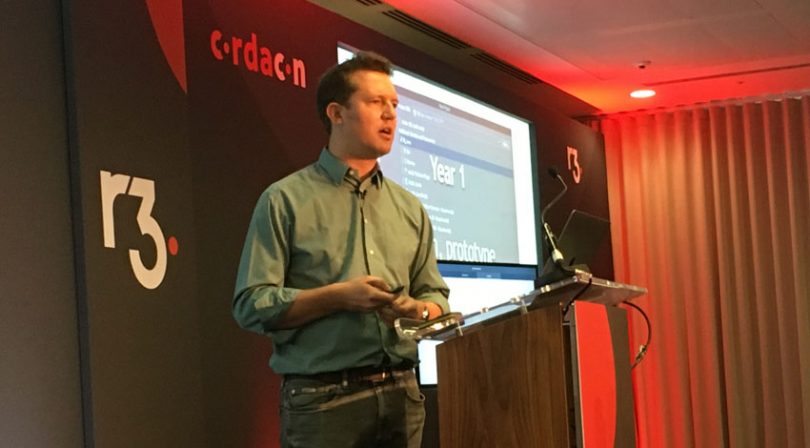This week’s R3 CordaCon in London had an enthusiastic tone, bordering on the evangelical. What was notable at the event was that a significant amount of the hype was coming from customers. Particularly those that have Distributed Ledger Technology (DLT) projects in production such as GuildOne in the energy sector.
Someone told R3’s CEO David Rutter that it was an ‘awesome movement’. He said: “That got me really jazzed up. I’m not sure what that means, but as long as I can commercialize a movement, I’m one happy man.” The event had 1151 attendees from 458 businesses.
But Rutter himself wasn’t short on enthusiasm: “Pretend for a moment that you have this crazy idea that you want to deploy new technology that could change everything about business, everything about the business processes… That thought is completely crazy, and who would attempt that? But we kind of have.”
Mike Hearn’s vision
Along the same lines, Lead Platform developer Mike Hearn gave a talk that was perhaps the highlight of the event. Rutter joked that Hearn, a former Bitcoin Core developer, is the most famous person in the company.
Hearn pondered the potential for millions of CorDapps. He noted that many of the current DLT applications are very large scale, so there will be fewer of them. But what if they weren’t so big?
He said: “Unlock a world where three people from three different companies can go into a conference room have a chit-chat and shake hands. And three days later they’ve got a CorDapp that automates anything they agreed in that conference room. And that’s it. There’s no complexity, no consortiums, no big deals, and marketing campaigns.”
“It’s just little ad hoc business processes that would traditionally be done by people because software development is too expensive. But we make it cheap enough and scaled down enough that we could end up with millions of these apps.”
He then asked the audience to envision these millions of apps combined with AI and asked the question: “Could you replace managers with robots,” and continued: “Can we start to automate the process of the management of business itself.”
Announcements
The event featured three announcements including the UK land registry project. The main announcement was the launch of the marketplace or app store that features more than 50 solutions based on Corda. And it also lists over 200 companies who are using Corda.
The smaller announcement was the Blockchain Global Trade Strategy Forum starting in October. The first topic will be about how blockchain can support EU and UK trade post Brexit. R3’s Adam Furgal quipped: “Because blockchain can solve all the world’s problems including Brexit”.
Many of the business talks were around topics previously covered in depth by Ledger Insights, such as trade finance (Marco Polo and Voltron), insurance (B3i, RiskBlock, InsureWave), syndicated lending (Finastra LenderComm), and identity.
There were also several themes that emerged during the conference.
Tokens
The first theme was R3 is getting serious about tokens. R3 Co-founder Todd McDonald has moved over from running partnerships to focusing on tokens, and there were multiple shout-outs encouraging attendees to chat with Todd about tokens.
Open source
On Developer Day there was a strong emphasis that Corda is open source and recognition of contributions from the community. There’s a perception in the marketplace that because R3 drives Corda, that it’s not truly open source. However, the software license is more permissive than Ethereum’s.
And there are increasingly significant contributions from the open source community. Perhaps the highest profile is Cordite, and their contributions were recognized by R3 several times during the conference.
The reason for the perception is there’s an Enterprise version of Corda. However, the enterprise product is focused around managing the network. Mike Hearn also acknowledged that others would create competing versions of Enterprise Corda, precisely because the base is open sourced. In fact, some have already built solutions that partially overlap with the Enterprise version.
For example, Hong Kong-based CryptoBLK showed a console that could monitor different applications or CorDapps on one screen. They’ve also released an open source integration between Corda and popular database Postgres.
But while the open source aspect increasingly appears real, it begs the question: what about R3’s business model? Ledger Insights has spoken to some of the most prominent solution providers in the tech space, and they were skeptical about a business model based on the core DLT software stack. However, R3’s model isn’t based on the core stack, that’s open source. Instead, it’s based on network management.
Hearn said he hopes that they can offer a sufficiently compelling enterprise solution to compete with open source offerings. It’s conceivable that smaller companies will go for open source solutions and larger corporates will adopt Corda Enterprise. Big companies will also want R3 support. And during the event, there was considerable positive feedback about the level of support, despite R3’s rapid growth.
However, roll forward a few years, and it’s conceivable that quite substantial companies could offer their competing enterprise versions.
Corda Enterprise leads on to the third theme of the event: the need for enterprise-grade network infrastructure to run an enterprise DLT.
Infrastructure for enterprise deployment
The emphasis on network infrastructure is a sign that more projects are getting to production phase.
So far one of the biggest tech names to go all-in on Corda is Hewlett Packard Enterprise (HPE). Major DLT projects involve large and complex multi-enterprise server networks that require management.
Raphael Davison, HPE’s Director of Blockchain, gave a talk that highlighted that many organizations focus on the ecosystem business model. But what about the ecosystem IT operating model? In other words what about managing the network infrastructure. HPE manages two out of three of the world’s credit card transactions, and they use a similar approach for DLT deployments.
Davison gave a metaphor of a typical mobile app user that might expect functionality, usability, a 360-degree view, security, availability, and predictable performance. The same applies to DLT infrastructure which needs to be addressed at an early stage. HPE also provide software and developer tools built on top of Corda Enterprise.
The lead event sponsor SIA is also a heavyweight network infrastructure provider. The company supports 40% of SEPA transactions which is the primary payment mechanism in Europe. They have a 600 node private network rather than using the public internet. They don’t host DLT nodes in their central datacenters. Instead, the plan is to build the DLT network via on-premises server deployments which they can manage on behalf of their customer.
Interoperability
The fourth theme was interoperability. The Corda Network was mentioned a few times but only discussed at a high level as it’s yet to formally launch. Corda has interoperability baked in, so simplistically it’s a matter of setting up the configuration, and different business networks can talk to each other.
So a trade finance network might talk to a separate insurance network. They might want to exchange assets, cash, and data with each other.
The final impression from the event is that DLT is very real and more and more projects are going into production. Those that have reached the production phase are even more bullish than others. As with all new technologies, there will be ups and downs, but for Corda right now it’s on the up.






